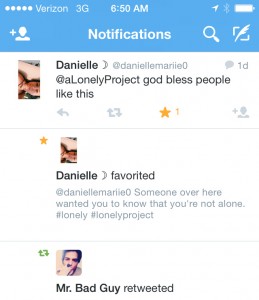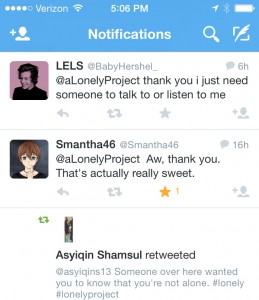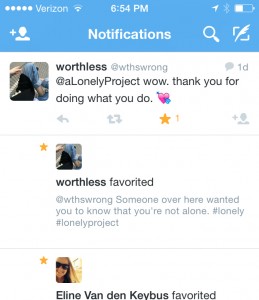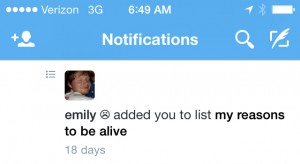Note:
Hello! Lauren, your neglectful blog author here. I haven’t posted since January so here’s a quick catch-up summary/litany of excuses:
- January – May: Freelance design, basically every spare evening and weekend I had. Learned a ton, but also stopped vacuuming and doing dishes and embracing the basic self-care one needs to perform to stay sane and enjoy life.
- May: Completed my graduate certificate in Emerging Design and Research at Penn.
- June: Accepted a new job as a marketing designer at the awesome local startup RJMetrics. Gradually learned to say no to side jobs. Started breathing again. Did a lot of outdoor yoga. Did a lot of vacuuming.
- July: 6-year anniversary living in this old house. I celebrated, as is customary in these last few years, by failing to notice the date had come and gone.
All this to say: I have no house updates for you. The weeds in my backyard are so massive they’re probably supporting their own complex ecosystems. But I would like to use this space to talk a little about the project I created as part of my design certificate. It’s my blog, I make the rules!
Why The Lonely Project?
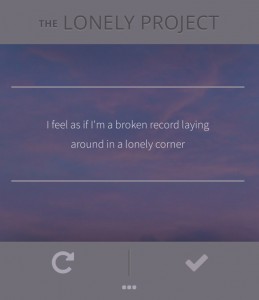 I wanted to do this project for at least a year, but bringing it to life was a struggle. At the beginning of the process, all I knew was this: I felt lonely. And I wanted to use that feeling to make something. Hopefully something useful. Something that would make myself less lonely, but maybe also something other people could use to do the same.
I wanted to do this project for at least a year, but bringing it to life was a struggle. At the beginning of the process, all I knew was this: I felt lonely. And I wanted to use that feeling to make something. Hopefully something useful. Something that would make myself less lonely, but maybe also something other people could use to do the same.
As the idea tumbled over and over in my head, not solidifying into anything particularly useful, I looked around for similar projects to serve as inspiration. But I didn’t find much. When you google loneliness, you get a lot of…stuff. There are definitions, and quizzes, and a wikihow entitled How to Deal With Loneliness: 15 Steps (with Pictures).
With pictures, you say? Well golly. I feel better already.
None of this seemed terribly compelling. What I really wanted was to read individual people’s words and hear about their experiences. I wanted to feel like there were other people out there working through the same emotions. And so when Penn offered to let me take a final class — a research-based independent study that would result in a culminating project — I decided it was time to force this nebulous idea out of my brain and try to create the thing I wished already existed: a sort of landing page for the lonely.
So, what did I make?
Simply put, The Lonely Project is a mobile website that displays tweets about loneliness. It’s programmed to search for any recent posts that use the words “I” and “lonely”. It also tries to exclude tweets about NOT feeling lonely, so what’s left are the direct words of people who are all currently experiencing the same emotion.
The site displays only the words of the tweet, one tweet at a time. You won’t see the name of the user, or their profile picture or location. And when a tweet is loaded you only have two options: you can load a new tweet to replace the current one, OR if the words on the screen move you, you can press the tweet button and the twitter account @aLonelyProject will reach out to the original poster for you. It sends a simple message:
Someone over here wanted you to know that you’re not alone. #lonely #lonelyproject
That’s it. A simple idea, and a simple site to match. It was still the most complicated thing I had attempted to code, but after receiving few PHP tips (via Twitter, of course), I got it up and running in late April of this year.
What have I learned?
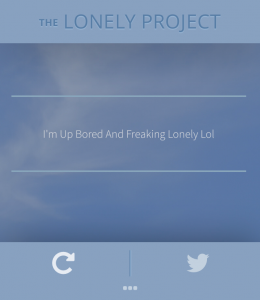 It’s difficult for people to talk about feeling vulnerable.
It’s difficult for people to talk about feeling vulnerable.
Some of us are completely comfortable putting the words “I’m really lonely” into the world, but many of us are not. We have a variety of ways of saying it without reeeeeally having to say it.
One common strategy is self-deprecation or humor. I see many, many tweets that follow the formula I honestly feel really terrible + “LOL”. People expect to be teased for coming across as weak, and there’s so much stigma surrounding mental health. Confessing that we feel less-than-stellar makes us nervous. So before anyone else can laugh at us, we laugh at ourselves. I know this is ridiculous, we say, but still…
Sometimes we say we’re lonely with emojis, or with gifs. But some of the most common tweets I see are song lyrics. Surprisingly (to me, at least), the most commonly posted lyric of all is this pair of lines from a twelve year-old 3 Doors Down Song:
“I’m here without you, baby / but you’re still on my lonely mind”
Occasionally, a user of The Lonely Project will hit the tweet button on a set of song lyrics and I’ll receive a reply along the lines of “thanks, but it’s just a song.” Someone else said it, we say. Someone else felt it. It’s not really me.
People really like hearing from the project!
When I first launched the site, I was very concerned that I’d get a lot of negative feedback from people who were essentially being surprise-tweeted by an unfamiliar account. It’s technically against Twitter’s terms of service to write a program that automatically sends at-replies based on a keyword search. Now, I would argue that @aLonelyProject isn’t REALLY auto-replying — each instance is triggered by a human interaction — but still, I understood that if the reaction to the project was poor, the account could be reported and shut down.
I recognized that the people whose words get featured on the site were sharing true moments of vulnerability, and of sadness. Would it be comforting to hear from this half-bot they didn’t know had been searching through their words? Or would it feel like an invasion of privacy? In short: would I be making people feel worse?
My instinct, though, was that Twitter users were posting these feelings publicly because they did want some kind of acknowledgement. And thankfully, that seems to be the case. As of yesterday, the account has tweeted 1,454 times and has received the following: 496 faves, 351 retweets, and 256 replies. Of the replies, only a handfull have amounted to “hey bot, fuck off.” Some people reply to express confusion, but the vast majority of feedback has been positive.
At the very least, over a third of the people contacted by the account are pleased enough to throw the tweet a fave. At best, this:
They may like hearing from it, but that doesn’t mean they’ll use it.
My plan for the project was that it would spread organically; someone would be contacted by the twitter account, the message would make them feel a bit better, and they’d follow the URL in the account’s bio info to start tweeting to others. And that does seem to happen, but not at the clip I was hoping. The most unique visitors the site has seen in one day is in the mid-50s. On a typical day it sees roughly 10 visitors.
Those visitors, though, spend much longer on this site than any of my other web-based projects. An average sessions is just over four minutes. And I know that most of the time @aLonelyProject posts, it’s not me using the site. But still, for those people sitting in bed with their smartphones and googling “I’m lonely” and looking for something to do about it, the project isn’t going to turn up in their search results. Yet. Nearly all referrals to the site still come through Twitter.
Other surprise findings?
Lonely people are desperate to interact with Justin Bieber.
Not really my thing, but hey.
What’s next?
I’ve had a lot of neat suggestions regarding The Lonely Project, from usability improvements to quantifying results. A coworker at RJMetrics suggested I perform a sentiment analysis on user’s tweets before and after the project interacts with them, to get a measurement of whether their mood has improved. As we like to say at work, “data or it didn’t happen.”
The site got a mention in a Washington Post article about automated Twitter accounts (sometimes called bots) as well:
Since then, artful programming has let people in chatrooms communicate with bots as if they were other people — and even communicate with other people through the intermediary of bots. The Lonely Project, by the Philadelphia botmaker Lauren Hallden, anonymizes tweets from people who say that they’re lonely, and invites readers to send them a comforting tweet, also anonymized through the bot.
“Someone over here wanted you to know that you’re not alone,” the tweet reads. It’s one of those rare instances when computer code and social media racket coalesce into something like magic.
I’ve also had a few invitations to speak about the project. I’ll be presenting it to a design class at Penn in the fall, and plans to bring it to a bot conference in Boston are in the works.
I’d love to hear your thoughts as well. And of course, if you’d like to tweet to some lonely people, feel free to use the project or give it a share. It’s at: laurenhallden.com/lonelyproject



